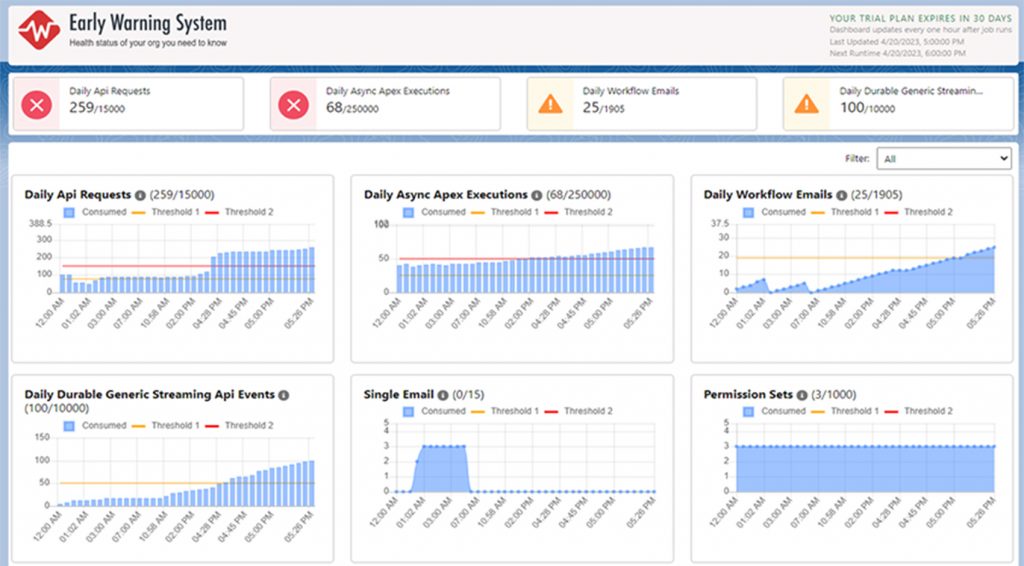Salesforce applications have revolutionized the way businesses operate by providing a streamlined platform for managing customer engagement and data efficiently. However, like any technology, there are limitations to what the platform can handle. Salesforce governor limits are an important consideration for businesses, as service disruptions can result in significant financial and reputational costs. This blog explores the impact of service downtime and provides insights on how to avoid disruptions by monitoring Salesforce governor limits consistently.
The Cost of Downtime
Downtime can have significant financial implications for businesses. Every minute of downtime can result in revenue loss, impacting a company’s bottom line. According to a recent Gartner study, the average cost of downtime is $5,600 per minute, or over $300,000 per hour, for large enterprises. According to the Ponemon Institute, each minute costs an average of $9,000, bringing the downtime cost per hour to over $500,000. For small businesses, the cost drops to the lower-but-still-significant tune of $137 to $427 per minute. These staggering numbers emphasize the need for businesses to adopt proactive measures to prevent service disruptions and downtime.
Best Practices and Solutions to Prevent Downtime
To prevent service disruptions and financial losses, businesses should proactively monitor critical Salesforce applications and conduct periodic design assessments. Additionally, establishing a robust incident management plan is crucial. Here are some best practices businesses can follow:
Proactive Monitoring
Proactive monitoring can prevent service disruptions and downtime. At Persistent, we have addressed the problem using a homegrown Salesforce lighting-enabled application called Early Warning System (EWS).
EWS is a Salesforce native app that provides proactive monitoring of over 90+ governor limits covering:

The app enables admins to track resource usage, identify patterns, and predict when governor limits may breach. With this proactive approach, admins can take pre-emptive action before resource depletion occurs, ensuring continuous operation of critical business applications and preventing service disruptions.
EWS offers a dashboard that displays critical resource utilization metrics, enabling admins to monitor resources at a granular level. The app provides email and chatter notifications when a specific threshold is reached, allowing them to take immediate action to prevent governor limits from being exceeded. Additionally, the app offers the ability to set custom thresholds based on specific needs, enabling businesses to tailor monitoring to their requirements. To learn more about EWS, click here.

Robust Incident Management Plan
Incident management is critical for the success of any business operation. It involves a set of processes and procedures designed to identify, analyze, and respond to incidents that disrupt the normal functioning of an organization’s applications and services. Businesses must also have a robust incident management plan in place to respond quickly to incidents and minimize downtime. The incident management plan should include clear communication channels, escalation paths, and defined roles and responsibilities. Additionally, businesses must conduct regular incident management drills to ensure the plan is up-to-date and effective.
Periodic Design Assessment
Proactive monitoring prevents service disruptions and ensures the application’s design can handle expected demand. Neglecting non-functional requirements during implementation can lead to future issues like system crashes, data loss, and harm to the business’s reputation and finances. Periodic design assessments identify potential bottlenecks, and Persistent’s Technology Adoption Program (TAP) framework offers a comprehensive Org Health Assessment, including design, architecture, performance, and security, with recommendations for best practices and out-of-the-box features. Learn more about it here.
Conclusion
To summarize, businesses need to understand the impact of Salesforce governor limits on critical applications to avoid disruptions while creating a scalable architecture design. There are several measures that organizations can take to prevent downtime:
- Implement an Early Warning System to monitor resource usage and take pre-emptive action
- Create a strong incident management plan
- Review application design and architecture regularly
Overall, proactive monitoring, proper application design, and efficient incident management are crucial for maintaining business reputation, financial stability, and ongoing success.






